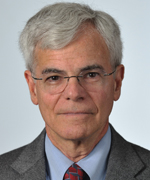From the Deputy Director for Intramural Research
Nourishing Intramural Research for the Long Term

Bob Dylan noticed it in 1963, and 50 years later we scientists are seeing it again: “The times they are a-changin’.” The conduct of science is evolving even though resources are restricted; barriers to turning innovative ideas into reality keep springing up while being torn down elsewhere. We all know about the many contributions that the intramural research program (IRP) has made to modern biomedical research (and I hope you all have your elevator speech ready in case someone challenges you on this), but how can we best mold the future to assure its continued success? In the words of Lewis Thomas, “The National Institutes of Health [IRP] is not only the largest institution for biomedical science on earth, it is one of this nation’s great treasures. As social inventions for human betterment go, this one is a standing proof that, at least once in a while, government possesses the capacity to do something unique, imaginative, useful, and altogether right.”
For the past nine months, I have been meeting with NIH leadership to discuss how best to prepare ourselves for the future. In January, I discussed a proposal for long-term planning for the IRP at the Leadership Forum of Institute Directors. In February the NIH scientific directors (SDs) met for their annual retreat—in the new FAES conference center on the B1 level of the Clinical Center, from 9:00 a.m. to 3:00 p.m.—sleeves rolled up and ready to work. With the encouragement of NIH Director Francis Collins, we have worked out a plan to develop a blueprint for the future of the IRP.
The planning process will begin at the level of our institutes and centers (ICs) with committees of our NIH experts and outside experts formulating a 10-year scientific vision for each of the ICs and determining what will be needed to accomplish these goals. These ideas will be discussed by the SDs and by a committee of institute directors, and the common themes that emerge will be identified and integrated into a single document.
My hope is that this process—beginning within the NIH with outside encouragement and support—will inspire creative, farsighted thinking. I know that for some IRP scientists, planning of this sort generates angst. A worry I have detected is that some of you don’t feel included in the process. And yet this is an inclusive process that will flounder without broad input. So, inclusive planning was the main topic for the 2014 IC Directors’ and SDs’ retreats. Collins opened both discussions and, in short, asked us to focus on the types of science that we do best. He charged us to articulate visionary goals and identify barriers to achieving these goals. He stressed the enthusiastic Congressional interest in the value and benefits of our research. He spoke eagerly of exciting scientific opportunities that have emerged in the past few years.
This 10-year vision is just the beginning. We encourage all NIH scientists to contribute innovative ideas about how we can continue to use the valuable resources of the IRP in laboratory science, clinical resources, and population-based programs to advance basic biomedical research and clinical applications. You are in a unique position to provide a bold vision for the future of the NIH IRP, with your keen insights into the special characteristics of this place.
Please send your best ideas to your scientific director and me for further consideration by the IC-based review groups. Once these individual groups have assembled their recommendations, we will identify common themes and goals. Before the end of the year, we will ask the Advisory Committee to the Director, comprising outside advisors, to review our efforts.
Think big. Think not what you could do with one more postdoc or a few more dollars. Instead think of unrealized synergies and focused investments for collaborative science to take on major scientific questions. A rising tide lifts all boats.
Elevator Going Up
VISITOR: Hey, I can see by your badge you work at the NIH. Any chance you can help me with my grant application?
IRP SCIENTIST: Actually, I’m on the intramural side?
VISITOR: Intramural? You mean some kind of volleyball league?
IRP SCIENTIST: No, the Intramural Research Program (IRP). We have about 1,000 PIs and 5,000 postdocs performing research at the NIH. Remember Marshall Nirenberg and the genetic code, Julius Axelod and humoral transmitters? Fluoride for tooth decay; lithium for bipolar mental illness; blood tests to detect HIV and hepatitis; the first AIDS drugs; the first vaccines against hepatitis, Hemophilus influenza, and human papillomavirus? That’s the IRP. We’ve had 20-some Nobel Prize winners and 30-some Lasker award winners.
VISITOR: Sure, but what have you done lately?
IRP SCIENTIST: Ketamine to reduce suicidal tendencies; immunotherapy to cure cancer; discovery of genes involved in stuttering and countless other disorders; world’s leader in MRI technology; Undiagnosed Diseases Program; world’s largest hospital dedicated to clinical studies… I’d tell you more, but this is my floor.
Continue the ride at https://irp.nih.gov/accomplishments.
This page was last updated on Wednesday, April 27, 2022
